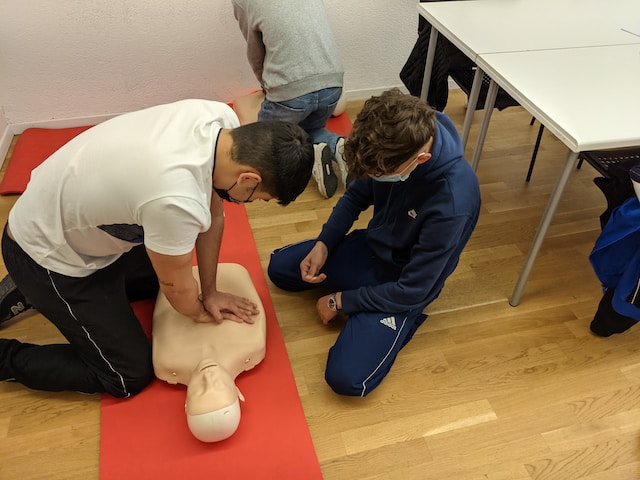EMR courses are available through colleges, private companies, and fire departments. The courses prepare students to be certified at the National Registry of Emergency Medical Technicians (NREMT) level.
EMR course participants complete 44 hours of online didactic textbook assignments before attending 36 hours of face-to-face psychomotor skills instruction. Then, they are ready for hospital and ambulance clinicals.
Become a part of a team.
EMRs are often the first medical professionals on the scene at a call. They help stabilize patients and determine their treatment plans while waiting for higher-level EMS personnel to arrive.
Students learn to recognize a variety of medical incidents, such as cardiac arrest, diabetic emergencies, and anaphylactic reactions. They will also be trained to administer emergency care and transport patients safely in an ambulance.
All EMS courses prepare students for the National Registry didactic and psychomotor exams (Emergency Medical Technician – Paramedic). Once they pass these exams, they can apply to their state for certification or license. This allows them to work in various settings, including hospital emergency rooms, industrial sites, city fire departments, and air ambulances.
Learn new skills
Learning new skills can help you gain confidence in your abilities. Whether you are looking to reduce your stress levels, advance in your career, or discover a new hobby, there are many benefits to picking up a new skill.
The Emergency Medical Responder course provides students National Certification and Texas State EMS Office certification as an Emergency Care Attendant. The course is designed for rural/frontier EMS agencies and individuals with schedules that do not allow residential systems.
The online portion of the emergency medical responder course Texas is self-paced and allows students to work independently. The in-person Skills Lab and Field Experience can be scheduled for a time that works with your daily schedule. This makes it easier to complete the training and get back to work.
Gain confidence in your abilities.
Students will complete classroom, skills sim, simulation lab, and ambulance ride-out assignments that will help them develop a realistic sense of urgency. They’ll also learn from experienced instructors who are passionate about their field and committed to assisting students to succeed.
It’s no secret that confident learners perform better in academic and professional spaces. Many studies show that confidence is the number one factor in learning success.
The EMR course is designed to teach students how to respond to medical and traumatic emergencies while they await higher-level EMS personnel to arrive. This training is excellent for high school and college-aged students to gain professional-level experience. It also meets and exceeds national EMS educational standards. Some students who plan to transfer should check with their intended college to ensure course credit is applicable.
Learn from experienced instructors.
In the classroom, you’ll work with a dedicated instructor who will guide you through the material in a way that makes sense. It offers the EMR course online so you can study when it’s convenient for you, then attend a 2-day skills session based on your schedule.
At the end of the program, you’ll be able to help patients in need and give them the care they deserve. With an Emergency Medical Responder certificate or degree, you’ll be on the front line of healthcare and can make a difference in someone’s life.
You can earn a full Emergency Medical Responder (EMR) certification and receive Basic Life Support Professional CPR training. EMR training teaches you to respond under medical oversight to patients experiencing pre-hospital medical or traumatic emergencies while awaiting higher-level personnel at the scene or during transport.
Make new friends
Unlike other premed extracurricular activities, you will work alongside medical professionals, allowing you to ask questions and learn from them. Plus, you’ll be able to build connections with people who may write letters of recommendation for your medical school applications.
Be prepared to deal with life-or-death situations, often in stressful and chaotic environments. This can be emotionally draining, so make friends in your class, join a peer support group or other social network, and practice healthy self-care. You’ll also be on your feet for a large portion of your shift and must be able to lift and carry patients weighing up to 250 pounds, so it’s essential to stay physically fit. The experience can be both exhilarating and exhausting, but it’s an invaluable part of your journey to becoming a doctor.




